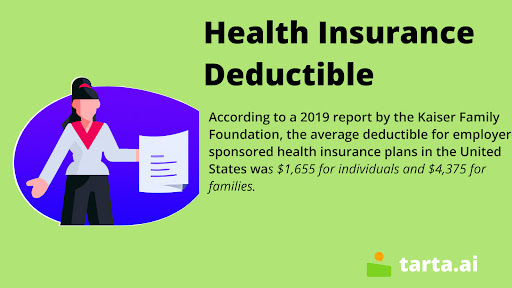Health Insurance Deductible: How Does It Work?

PHOTO: tulsagastro.com
What is Health Insurance Deductible?
A health insurance deductible is the amount of money that an insured person must pay out of pocket for healthcare services before their insurance policy starts covering the costs. Deductibles are typically expressed as a dollar amount, such as $1,000, and can vary depending on the type of insurance plan.
For example, if you have a $1,500 deductible and you receive a medical bill for $3,000, you would be responsible for paying the first $1,500 out of pocket, and your insurance company would then start paying a portion of the remaining $1,500, depending on the terms of your policy.
After the deductible is met, your insurance plan may still require you to pay copays, coinsurance, or other out-of-pocket costs until you reach your plan's out-of-pocket maximum. Once you reach the out-of-pocket maximum, your insurance plan typically covers the remainder of the costs for the covered services.
Types of Health Insurance Deductible
- Individual Deductible: This is the amount of money that an individual must pay out of pocket before their insurance plan begins covering the costs.
- Family Deductible: This is the amount of money that a family must pay out of pocket before their insurance plan begins covering the costs. Once the family deductible is met, the plan typically begins covering costs for all members of the family.
- Embedded Deductible: An embedded deductible is a feature of some family health insurance plans that allow each individual family member to have their own deductible. Once an individual meets their own deductible, their insurance plan begins covering costs for that individual, even if the overall family deductible has not been met.
- Aggregate Deductible: This is the total amount that a family must pay out of pocket for healthcare expenses during a given period, regardless of which family member incurs the expenses. Once the aggregate deductible is met, the insurance plan begins covering costs for all family members.
It's important to note that deductibles can vary depending on the specific insurance plan and provider, and not all plans offer all types of deductibles. It's important to carefully review the terms of a health insurance plan and consider personal health care needs when choosing a deductible type.

How Deductibles Work
Health insurance deductibles work by requiring the insured person to pay a certain amount of money out of pocket for healthcare services before the insurance policy begins covering the costs.
Here's how it typically works:
- You receive healthcare services that are covered by your insurance plan.
- You pay for these services out of pocket until you reach your deductible amount.
- Once you have paid your full deductible amount, your insurance policy will begin covering a portion of the remaining costs for covered services.
- You will continue to pay any required copays, coinsurance, or other out-of-pocket costs until you reach your plan's out-of-pocket maximum.
- After you have reached the out-of-pocket maximum, your insurance policy will typically cover the remainder of the costs for the covered services.
It's important to note that deductibles typically reset each year, which means that you will need to meet the deductible amount again at the start of each new coverage period.
It's also important to understand that different insurance plans may have different rules and requirements when it comes to deductibles. For example, some plans may require you to pay a separate deductible for certain types of healthcare services, while others may have separate deductibles for different family members. Be sure to review the terms of your insurance plan carefully to understand how your deductible works.
NOTE
Deductibles can change each year: Deductibles typically reset each year, which means that you will need to meet the deductible amount again at the start of each new coverage period. It's important to review your plan each year to understand any changes to the deductible amount or other plan details.
Impact on Premiums
The deductible amount you choose can have a significant impact on your monthly health insurance premiums. In general, plans with higher deductibles will have lower monthly premiums, while plans with lower deductibles will have higher monthly premiums.
This is because higher deductible plans shift more of the financial responsibility for healthcare costs onto the insured individual, which reduces the insurer's risk and allows them to offer lower premiums. On the other hand, plans with lower deductibles provide more coverage upfront, which increases the insurer's risk and leads to higher premiums.
It's important to note that the relationship between deductibles and premiums can vary depending on the specific insurance plan and provider. For example, some plans may have relatively high premiums even with a high deductible, while others may offer lower premiums with a low deductible.
When choosing a health insurance plan, it's important to consider your personal healthcare needs and budget, as well as your ability to pay for out-of-pocket costs. If you are generally healthy and don't anticipate needing a lot of healthcare services, a plan with a higher deductible and lower monthly premiums may be a good option. However, if you have a chronic condition or expect to need frequent healthcare services, a plan with a lower deductible and higher monthly premiums may be a better choice to help manage your costs.\

PHOTO: Goldman Lukic/GETTY IMAGES
Choosing the Right Deductible
Choosing the right health insurance deductible can be a difficult decision. Here are some tips to help you choose the right deductible for your needs:
- Consider your budget: It's important to choose a deductible that you can afford to pay out of pocket if needed. Take a look at your monthly expenses and savings to determine what you can comfortably afford.
- Consider your healthcare needs: Think about the types of healthcare services you typically need and how often you use them. If you have a chronic condition or need frequent medical care, a lower deductible may be a better choice to help manage your costs.
- Consider your risk tolerance: If you are generally healthy and don't expect to need a lot of medical care, a higher deductible plan may be a good option to save money on premiums. However, if you prefer to have more predictable out-of-pocket costs, a lower deductible plan may be a better choice.
- Compare plan options: Look at different health insurance plans to compare deductible amounts, premiums, and coverage. Consider using an online health insurance marketplace or working with a licensed insurance agent to help you compare options.
- Understand the plan details: Make sure you understand the terms of the health insurance plan you choose, including any limitations or exclusions. Review the plan's summary of benefits and coverage and ask questions if you need clarification.
Remember, the right health insurance deductible will depend on your personal healthcare needs, budget, and risk tolerance. Take the time to carefully consider your options and review plan details to choose the best deductible amount for your situation.
Important
Take an inventory of your medical history and lifestyle while choosing health insurance deductible to determine how often you typically need medical care. If you generally have good health and rarely visit the doctor, a higher deductible plan may be a better choice. If you have a chronic condition or require frequent medical care, a lower deductible plan may be a better fit.
Meeting Your Deductible
Meeting your health insurance deductible means that you have paid the full amount of your deductible for the year, after which your insurance coverage typically kicks in and starts paying for a portion of your medical expenses.
For example, if you have a health insurance plan with a $1,000 deductible and you have already paid $1,000 out of pocket for covered medical expenses, you have met your deductible for the year. After meeting your deductible, you may be responsible for paying coinsurance or copayment fees, which are typically a percentage of the total cost of medical services.
It's important to note that not all health insurance plans work the same way when it comes to meeting your deductible. Some plans may have separate deductibles for different types of medical services, such as prescriptions or hospital stays, while others may have a combined deductible that applies to all medical services.
Be sure to review your health insurance plan's summary of benefits and coverage to understand how your deductible works and what costs you are responsible for before and after meeting your deductible.
- A health insurance deductible is the amount of money you are responsible for paying out of pocket before your insurance coverage kicks in and starts paying for medical expenses.
- There are different types of deductibles, including individual deductibles, family deductibles, and high-deductible health plans.
- The amount of your deductible can impact your monthly premiums and out-of-pocket costs for medical care.
- When choosing a deductible, it's important to consider your healthcare needs, budget, and risk tolerance.
- Meeting your deductible means that you have paid the full amount of your deductible for the year and your insurance coverage typically kicks in and starts paying for a portion of your medical expenses.
- Be sure to review your health insurance plan's summary of benefits and coverage to understand how your deductible works and what costs you are responsible for before and after meeting your deductible.
FAQ
Q: What is a health insurance deductible?
A: The amount of money you must pay out-of-pocket before your insurance company begins to cover your medical expenses.
Q: How does a deductible work?
A: If your deductible is $1,000, you must pay the first $1,000 of your medical expenses before your insurance kicks in. After you meet your deductible, you typically only pay a copayment or coinsurance for covered services.
Q: What is the difference between a deductible and an out-of-pocket maximum?
A: A deductible is the amount you pay before your insurance begins to cover your medical expenses. An out-of-pocket maximum is the maximum amount you will pay in a given year for covered services, including your deductible, copayments, and coinsurance.
Q: Can you choose your deductible amount?
A: Yes, when you enroll in a health insurance plan, you will typically have a choice of several different deductible amounts to choose from.
Q: What are some factors to consider when choosing a deductible amount?
A: Consider your expected medical expenses for the year, your budget, and how much you can afford to pay out-of-pocket if you need medical care.